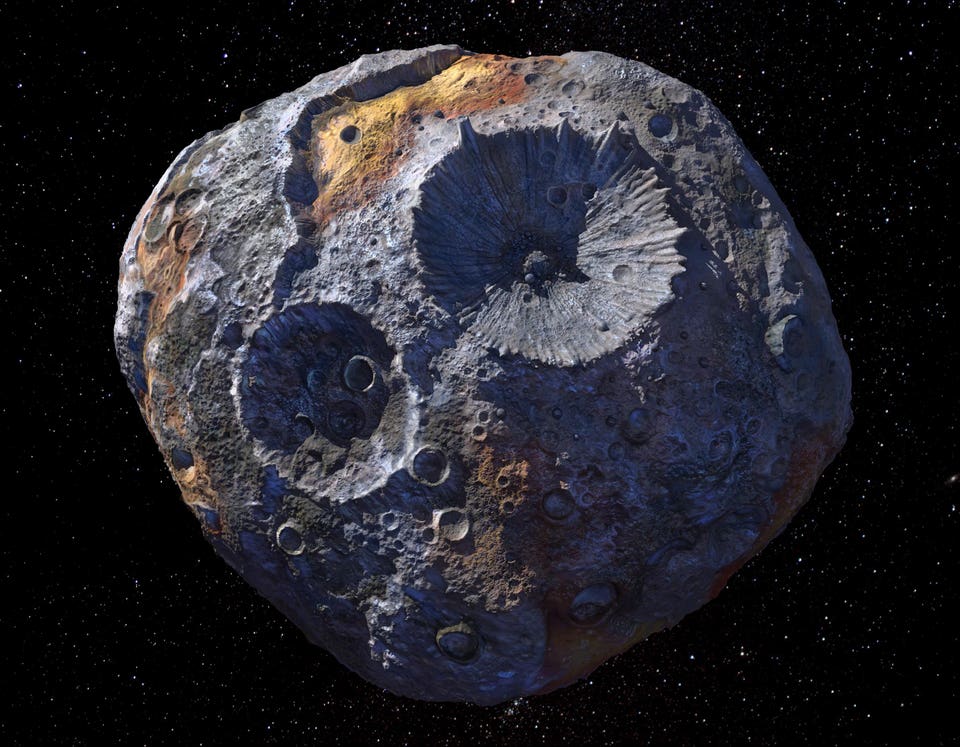Forbes Innovation Science NASA Adds ‘Wings’ And Lasers To Imminent Mission To ‘Psyche’ Asteroid Jamie Carter Senior Contributor Opinions expressed by Forbes Contributors are their own. I inspire people to go stargazing, watch the Moon, enjoy the night sky Following Aug 14, 2023, 07:15pm EDT | Press play to listen to this article! Got it! Share to Facebook Share to Twitter Share to Linkedin This artist’s concept depicts the 140-mile-wide (226-kilometer-wide) asteroid Psyche, which lies in . .
. [+] the main asteroid belt between Mars and Jupiter. NASA/JPL-Caltech/ASU NASA’s landmark Psyche mission to reveal the most metallic object ever observed has been fitted with huge solar arrays and an all-new communications device that uses lasers.
The Psyche mission—part of NASA’s Discovery Program—will launch atop a SpaceX Falcon Heavy rocket from Space Launch Complex 39A at Kennedy Space Center at 10:38 a. m. EDT (7:38 a.
m. PDT) on Thursday, October 5, 2023. It’s hoped the mission will reveal the truth about 16 Psyche, an object presumed to be the most metallic and most valuable asteroid yet discovered.
The asteroid is thought to be the core of a planetesimal—the precursor to a planet—which could teach scientists about how Earth formed. In recent months the tennis court-sized spacecraft has been readied for launch in a clean room near NASA’s Kennedy Space Center in Florida, with the most recent addition being its twin solar arrays. Technicians begin to retract one of the two solar arrays attached to NASA’s Psyche spacecraft.
This . . .
[+] photo was taken on July 25 inside the Astrotech Space Operations facility near the agency’s Kennedy Space Center in Florida. NASA/Kim Shiflett MORE FOR YOU See A Slim Moon Close To Mars As ‘Shooting Stars’ Fall: The Night Sky This Week Perseid Meteor Shower Peaks Tonight How And Where To Watch The Next Big Meteor Shower Could See A Huge Outburst Say Scientists Psyche Gets Wings The massive solar arrays—which look like wings—measure 800 square feet (75 square meters) and include five solar panels, according to NASA . They’re tucked away on the sides of the orbiter until the spacecraft leaves Earth, after which they will unfurl to provide 20 kilowatts of power for the 2.
5 billion miles, six year journey to the asteroid. However, by the time the Psyche spacecraft reaches the asteroid the power of the sun will be drastically lower, with the solar arrays thus only able to provide about 2 kilowatts to the spacecraft. That’s about the same as a hair dryer.
MORE FROM FORBES NASA Is Set To Explore A Massive Metal Asteroid Called ‘Psyche’ That’s Worth Way More Than Our Global Economy By Jamie Carter Space Lasers Hitching a ride on the Psyche spacecraft this fall will be a new experiment from NASA to test the use of lasers—rather than radio—for data transfer in space, according to NASA . During the first two years of the journey to the asteroid the Deep Space Optical Communications (DSOC) project will see a transceiver on Psyche communicate with two ground stations in Southern California to test laser transmitters and detectors as well as new decoding methods. The Hale Telescope at Caltech’s Palomar Observatory in San Diego County, California, will receive .
. . [+] the high-rate data downlink from the DSOC flight transceiver.
The telescope is fitted with a novel superconducting detector that is capable of timing the arrival of individual photons from deep space. Palomar Observatory/California Institute of Technology Mars live in HD It’s hoped that one day lasers—i. e.
light—can be used for ever-faster and much higher bandwidth communications between Earth and spacecraft at Mars. “DSOC was designed to demonstrate 10 to 100 times the data-return capacity of state-of-the-art radio systems used in space today,” said Abi Biswas, DSOC’s project technologist at NASA’s Jet Propulsion Laboratory in Southern California. “High-bandwidth laser communications for near-Earth orbit and for Moon-orbiting satellites have been proven, but deep space presents new challenges.
” It’s hoped that HD photos and even live video can one day be transmitted over billions of miles of deep space. Wishing you clear skies and wide eyes. Follow me on Twitter or LinkedIn .
Check out my website or some of my other work here . Jamie Carter Editorial Standards Print Reprints & Permissions.
From: forbes
URL: https://www.forbes.com/sites/jamiecartereurope/2023/08/14/nasa-adds-wings-and-lasers-to-imminent-mission-to-psyche-asteroid/



